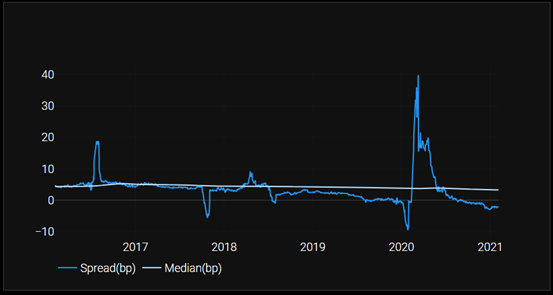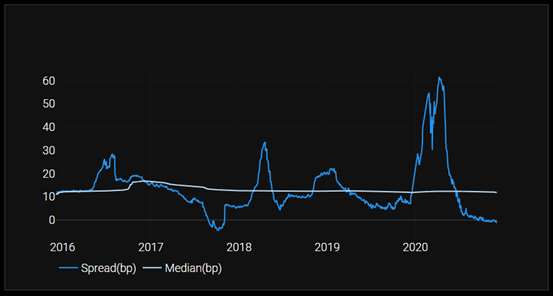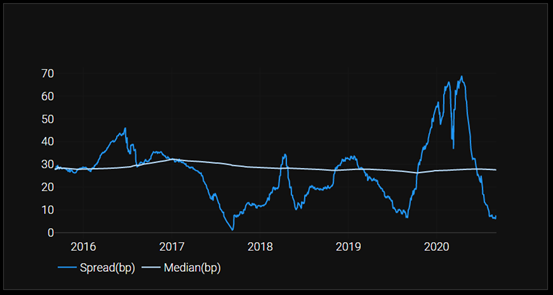Most active market participants were looking forward to the LIBOR cessation or pre-cessation announcement to provide certainty for the end of LIBOR. This was provided by FCA on 5th March 2021 as a pre-cessation or ‘loss of representativeness’ announcement which triggered many contracts to move to the fallbacks at a future date.
However, another component of the announcement was the proposed consultation on ‘synthetic LIBOR’ for GBP (and probably JPY as well) which may be applied to contracts without the pre-cessation trigger. This means that LIBOR can be effectively continued for contracts not subject to the pre-cessation trigger because IBA will still publish LIBOR under a methodology directed by FCA.
Although this looks like a good solution to the vexed problem of ‘tough legacy’ (i.e. trades or contracts where it is not feasible to replace the fallbacks in a timely manner) this is not without challenge.
What is the synthetic LIBOR methodology going to be? Should it follow the term SONIA plus a fixed spread? Or should the spread be dynamic and follow market credit and liquidity changes?
Different products and users of those products may prefer (or require) very different characteristics from the new methodology to maintain the integrity of those products.
A product approach
Different products may actually prefer different forms of synthetic LIBOR. In some cases, a dynamic credit spread may be essential but for other products a fixed spread similar to the ISDA version may be more appropriate.
This is an example where a dynamic spread may be preferred:
Short-term, draw-down facilities (e.g. multi-currency revolving loans)
The reference rate is often short-term LIBOR which currently varies with underlying rates and liquidity in the markets. When short-term liquidity is low, the spread rises and the bank matches their funding costs to the lending rate on the facility.
If the spread was fixed, many banks have pointed out that these loans are problematic because market rates diverge from the fixed spread and the facility is undercharging for the drawdown.
In this case, a dynamic spread is preferred.
And here is an example where a fixed spread may be a better option:
Debt hedged with derivatives (e.g. debt issued and swapped to another currency)
Floating rate debt such as FRNs are often issued in one currency and swapped to another currency using cross currency swaps. If the derivative has a fallback which is based on the ISDA approach (i.e. fixed spread) then the FRN, if it remains on LIBOR, would be better hedged with a synthetic LIBOR similar in methodology to the ISDA approach using a fixed spread.
These two simple examples show how different product can require quite different synthetic LIBORs to maintain their integrity and perform as expected.
Cliffs and steps for fallbacks – the dynamic versus fixed spread
I have previously looked at the challenges of cliffs and steps on the day the fallbacks become effective. Murex has also contributed to the debate and as we approach the 31st December 2021 there appears to be a real possibility of a step up in the rates applied post LIBOR.
Quite ironically in Q2 2020 when we first looked at the discontinuous curve around the transition to fallbacks we were expecting a cliff, i.e. a sharp fall in rates between 31st December2021 and 3rd January 2022 whereas now it is more likely to be a step up in rates.
Firstly a few charts from Clarus CHARM.
The first shows the 1-month GBP LIBOR and the median 5-year spread to the compounded SONIA. As we have discussed previously, LIBOR (the blue line) does move around relative to the 5-year median (white line)
If, for example, today was the 31st December 2021 then LIBOR would set at around 0.04738% but the following day (3rd January 2022) LIBOR would ‘step up’ to 0.08120% being the compounded SONIA 1 month (0.0486) plus 5-year median spread (0.0326). The Term SONIA is 0.0486% but we will deal with that later in the blog.

A very similar effect is seen in the 3-month chart with a step up from LIBOR at 0.08500% to 0.1702% comprised of compounded SONIA of 0.04860% and the 5-year median spread of 0.11930. Term SONIA is 0.0490% which will also be discussed later in the blog.

And the same effect is seen in the 6 month LIBOR chart below.

But the main feature of these charts is the fact that LIBOR is often very different to the compounded rate plus the spread and occasionally equal. LIBOR spends more time not equal to the compounded rate plus the spread.
Term SONIA
A synthetic LIBOR needs to be forward-looking and Term SONIA appears to be a usable solution. However, the analysis here was done using the compounded, set in arrears SONIA because the Term SONIA historical rates are not available.
The variability of GBP LIBOR when compared with Term SONIA is expected to be similar to that described in this analysis. The decision of a synthetic LIBOR with a fixed or variable spread to the Term SONIA is still a matter for consultation.
Should the synthetic LIBOR follow the cliff or step?
While it is tempting to have synthetic LIBOR follow the path of the fallbacks with a cliff or spread effect there are some subtle differences.
If the name is correct, then a synthetic LIBOR could be expected to replicate LIBOR and vary from the ISDA fallbacks (compounded rate plus the fixed spread) as credit and liquidity conditions change.
The possible step up could disadvantage some participants who would see a sudden change in their borrowing rates creating winners and losers. The size and direction of the cliff or step will only be known on 31st December 2021 but is unlikely (see previous charts) to be zero.
Synthetic LIBOR with a fixed spread
If a fixed spread is used it will differ from the ISDA/Bloomberg spread for derivatives. The derivative spread is based on LIBOR minus the backward-looking compounded SONIA (note the timing difference) whereas the synthetic LIBOR spread would need to be calculated as the difference between LIBOR and the forward-looking SONIA. These spreads are potentially quite different.
In this case, the fixed spread would be unlikely to replicate the current LIBOR because the variable credit and liquidity spread is removed and replaced by a fixed 5-year median.
This could be advantageous for some products like longer-dated loans with swap hedges but also negatively impact other products like short-term drawdown facilities which are linked to actual cost of funds at that moment.
Synthetic LIBOR with a floating spread
If the spread is allowed to change and follow the market credit and liquidity changes (as does LIBOR) then such a synthetic LIBOR may be a better fit for some products which depend on replicating actual funding rates in the market. [As a side note, this was the original intent of LIBOR – to replicate actual borrowing rates.]
But how would such a dynamic spread be calculated each day? Although the process is not clear in GBP, the USD market is actively pursuing a ‘credit add-on’ for SOFR by IHSMarkit, IBA and Bloomberg.
It is possible and potentially suits some products to create a synthetic LIBOR more like the current LIBOR with a floating spread tracking actual funding rates.
Synthetic LIBOR
The question of the synthetic LIBOR methodology is the subject of an FCA consultation very soon. On one hand, a fixed spread added to the Term SONIA may be attractive for some participants while a variable spread added the Term SONIA be better suited to other participants.
If I assume there can only be one synthetic LIBOR (to avoid the obvious arbitrage opportunities) then a decision on the type of spread will be critical.
Inevitably there will be ‘winners’ and ‘losers’ whichever option is finally adopted.
Summary
The upcoming consultation on synthetic LIBOR by FCA will be very important as the outcome will impact different products and some participants quite substantially.
Should the spread be variable or fixed? And if it is variable, then how might this be calculated?
And as always, Clarus CHARM, Microservices and Clarus Data provide a necessary toolkit for managing your exposures.

John I would argue that it doesn’t matter what the result of the consultation is. Snythetic LIBOR should only be used when there is no other choice, last resort, the “airbag” to prevent any systemic events. Market participants should instead actively tear up and replace existing contracts with RFR structures. In this case, we do not want Synthetic LIBOR to be too much of an attractive solution, otherwise no one will bother to transition. Similar to how the ISDA fallbacks are not a transition tool, and therefore have limitations, the same will be the case for synthetic LIBOR. Active transition is the only way to ensure there are no adverse PnL or Risk impacts to these “tough-legacy” products.